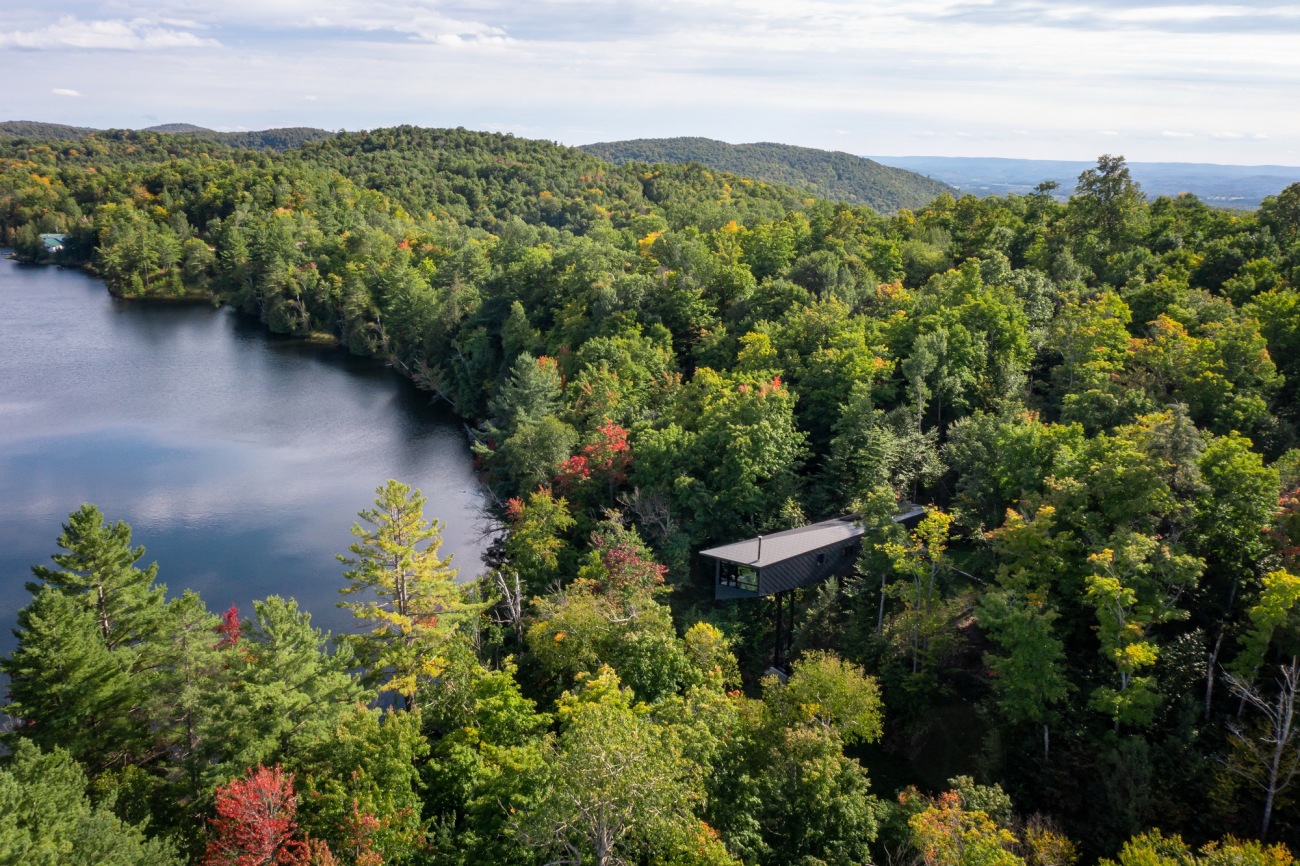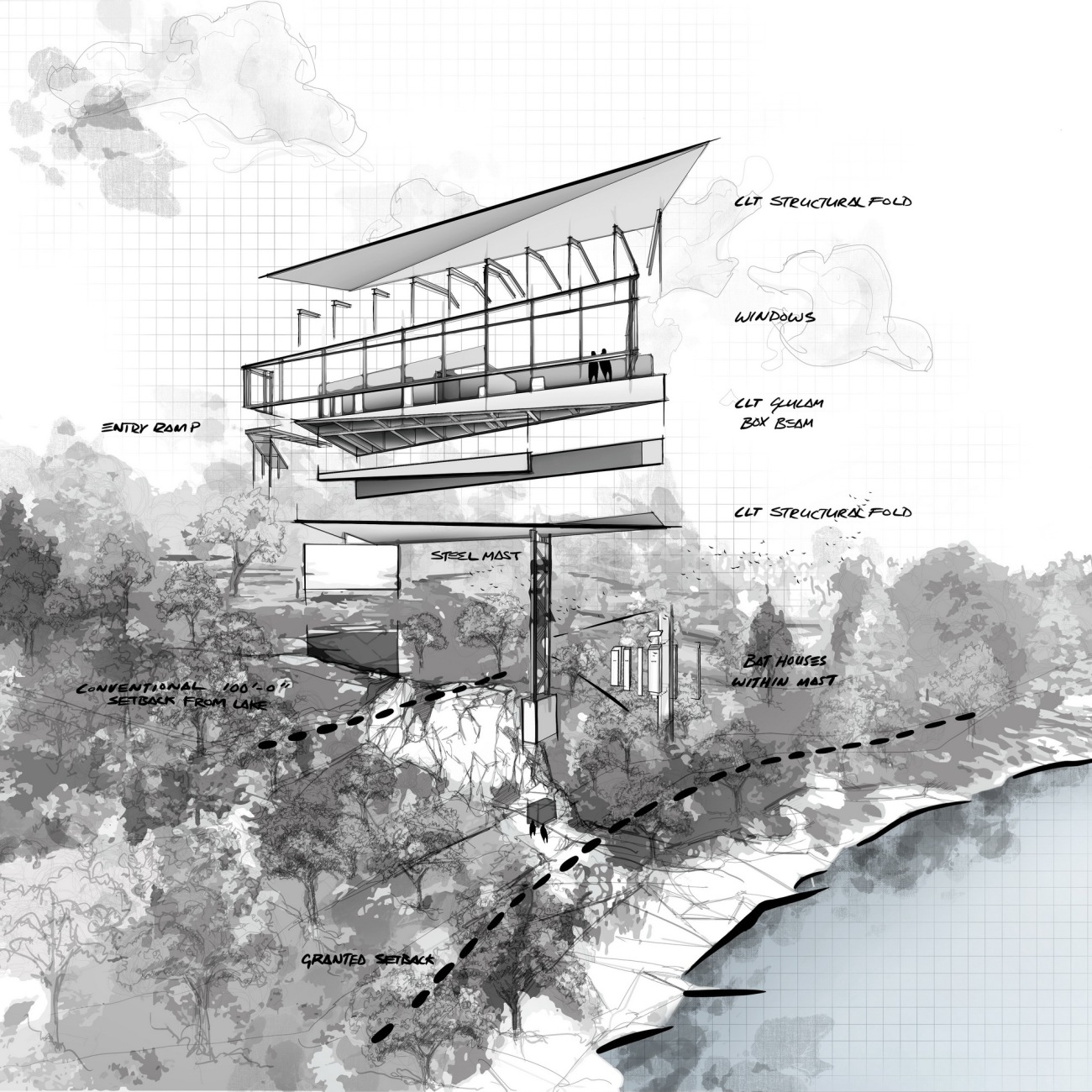| 公司: | Kariouk Architects | 类型: | 建筑 |
|---|---|---|---|
| 地区: | 中国 | 标签: | 艺术装置 |
典型的北美小屋被浪漫地描绘为荒野中的小木屋。实际上,这些小屋是郊区住宅的“林中”版本,配备了所有现代化的便利设施。这些建筑有助于维持这样一种神话:由于它们看起来与土地融为一体,所以它们的主人对环境的影响较小。
The paradigmatic North American cottage is romanticized as a wilderness log cabin. Nonetheless, typical cottages are “woodsy” versions of suburban homes with every modern convenience. These buildings sustain the myth that appearing to be one with the land equates to a reduced impact on the environment.
CLT Cabin 颠覆了这一理念,它与其他小屋相比,与景观分离,建造方式更加可持续。这种打破生态虚构的意图不是玩世不恭,而是负责任的乐观主义。虽然所有有机环境都在继续退化,但剩下的部分可以得到更负责任的利用。
The m.o.r.e. Cabin inverts this idea through a separation from the landscape that is more sustainably
constructed than other cottages. This unravelling of eco-fictions is not cynical, but optimistic: while
organic environments are being degraded, what remains can be engaged more responsibly.
more CLT Cabin 通过多种方式尝试轻轻触碰土地:
创造性地解释法律以维护其原则。
使用钢桅杆来减小地基的尺寸。
低废料交叉层压木材(CLT)结构。
使用“折叠”结构来获得更大的抗拉强度。
离网电力和高效加热。
为当地濒危的蝙蝠创建家园。
To this end, m.o.r.e. Cabin touches the land lightly through:
- Interpreting the law creatively to uphold its principles.
- Reducing foundation size through a steel mast.
- Low-waste cross-laminated timber (CLT) structure.
- Achieving greater tensile strength through a “folded” structure.
- Off-grid power and high-efficiency heating.
- Creating a home for endangered bats.
巧妙解读法律
Interpreting the Law with Finesse
该地区的分区规划要求与湖面保持 100 英尺(30 米)的距离。设计中将 100 英尺处的悬崖面纳入其中,而通常情况下,这处悬崖面会被炸毁。
为了尽量减少对附近山坡和森林的破坏,我们进行了分区变更,以允许更多 CLT 小屋的正面悬停在 75 英尺(30 米)标记之上。经过两年的法律挑战,我们赢得了胜利,并接受了体现挫折精神的解决方案。
Zoning rules required a 100-foot (30-metre) setback from the lake. A cliff face at that 100-foot mark was incorporated into the design, whereas conventional construction approaches would entail blasting.
To minimize harm to the hillside and forest, a zoning variance was obtained to allow the front of m.o.r.e. Cabin to hover above, rather than sit on, the 100-foot (30-metre) mark.
桅杆
The Mast
解决该环境问题的技术方案涉及在所需的退缩范围内放置一个单一的混凝土基础和一个钢“桅杆”。
避免使用传统的大型地基,可以保护流域的植物和土壤,防止侵蚀,并将施工区抬高到山坡以上。由于混凝土是建筑中最大的排放源之一,减少混凝土的使用可以大大降低项目的碳足迹。
The technical solution to the environmental issue involved a single concrete footing and a steel “mast” placed within the required setback.
Avoiding a conventional large foundation preserved the watershed and prevented erosion, as did
elevating the construction zone. Use of carbon-intensive concrete was also reduced for a lower carbon footprint.
装修房屋的方法不止一种
m.o.r.e. Than One Way to Skin a Home
更多 CLT 小屋采用合适来源的 CLT 面板和胶合木梁建造。
CLT 完全在场外铣削,然后吊装到位,最大限度地缩短了施工时间,避免了施工机械操作对景观的破坏。所有建筑材料的尺寸都适合较小的短拖车,以防止砍伐路边的树木。
m.o.r.e. Cabin is built with suitably-sourced CLT panels and glulam beams.
The CLT was milled offsite then hoisted into place, avoiding damage to the landscape by the maneuvering of construction machinery.
舱室为梁
Cabin-as-Beam
更多 CLT Cabin 的环境考虑带来了结构创新。通过悬臂满足分区差异通常需要使用胶合板,这种材料在张力下非常坚固,但需要浪费结构框架。挑战变成了制定一种结构策略来使用张力下的 CLT 面板。
传统的 5 层 CLT 太重,无法支撑较长的跨度。解决方案使用更薄的 3 层 CLT,通过“折叠”确保结构承载力(就像纸折叠时会变硬一样)。
m.o.r.e. Cabin’s environmental considerations yielded structural innovation. Our challenge became to
develop a structural strategy using cantilevered CLT panels as a response to the zoning variance that we obtained; CLT is fundamentally deployed in vertical/compressive sections, not horizontally in tension.
Conventional 5-ply CLT is too heavy to support itself over longer spans. The solution used thinner 3-ply CLT, with structural capacity ensured through “folding” (just like paper gains strength when folded).
离网
Off-Grid
房屋由太阳能装置供电。小屋通过 12 英尺的内部高度和高于湖面的额外高度,充分利用了微风和交叉通风,以实现降温。尽管小屋距离地面约 20 米,但在温暖的月份,其朝南的玻璃墙会被周围的树冠遮蔽。在冬天,光秃秃的树枝让大量阳光透过大窗户照进来,有助于为房屋供暖。
CLT 具有良好的 R 值和热舒适度,这得益于其质量和气密性,而气密性是由精密的接合工艺产生的。热量由高效的“绿色碳”木材炉提供(因为木材不是从地下深处运来的化石燃料,所以它不会增加现有的碳循环)。
The home is solar-powered.
The elevated cottage catches more breezes and has excellent cross-ventilation. Heat is provided by a
high-efficiency “green carbon” wood stove. Good R-value and thermal comfort are provided by CLT’s
mass, and precise joinery provides air-tightness.
 |  |
邀请邻居来访
Inviting Over the Neighbours
建造这座房屋的一个目标是为濒临灭绝的棕蝠提供宽敞的栖身之所。蝙蝠舱被整合到桅杆中,以保护蝙蝠免受攀爬掠食者的伤害,并开辟一条通往湖泊的清晰飞行路径。
One goal of the home was to create extensive lodging for endangered brown bats. Bat pods were
integrated into the mast to provide safety from climbing predators and a clear flight path to the lake.
*“m.o.r.e.” stands for the clients’ immigrant grandmothers’ names; all of whom did more with less — and gracefully so.
▽平面图,plan
▽效果图,Rendering
Firm Information
Office Name: Kariouk Architects
Office Website: https://kariouk.com/
Social Media Accounts:
Instagram: Kariouk Architects
Facebook: Kariouk Architects
LinkedIn: Kariouk Architects
Firm Location: Ottawa, Ontario, Canada
PROJECT INFORMATION
Project Name: m.o.r.e. CLT Cabin
Completion Year: 2021
Gross Built Area (m2/ ft2): 1000 ft2
Project Location: Lac Du Brochet, Wakefield, Quebec, Canada
Program: Residential
CREDITS
Design Team:
Paul Kariouk (Principal)
Chris Davis (Project Architect)
Adam Paquette (Intern Architect)
Frederic Carrier (Design Associate)
David King (Design Associate)
Sarah McMurtry (Design Associate)
Steven Schuhmann (Design Associate)
Joel Tremblay (Design Associate)
General Contractor: GPL Construction
Structural Engineer: Daniel Bonardi Consulting Engineers
Heavy Timber Consultant: StyxWorks
Heavy Timber Assembly: Laverty Log HomesCLT, Glu-Lam, and Specialty Steel: Zublin Timber
Photographer: Scott Norsworthy
更新日期:2024-07-18 16:48:20
非常感谢 Kariouk Architects 带来的精彩项目, 查阅更多Appreciations towards Kariouk Architects for sharing wonderful work on hhlloo. Click to see more works!























